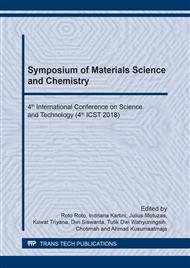[1]
P.M. de Sales, P.M. de Souza, L.A. Simeoni, P. de O. Magalhães, D. Silveira, α-amylase inhibitors: A review of raw material and isolated compounds from plant source, J. Pharm. Pharm. Sci. 15 (2012) 141–183.
DOI: 10.18433/j35s3k
Google Scholar
[2]
S. Challa, Role of Antidiabetic compounds on glucose metabolism – A special focus on medicinal plant: Salacia sps, Med. Chem. (Los. Angeles) 4 (2014) 373–381.
DOI: 10.4172/2161-0444.1000168
Google Scholar
[3]
S. Kumar, V. Kumar, O. Prakash, Enzymes inhibition and antidiabetic effect of isolated constituents from Dillenia indica, Biomed Res. Int. 2013 (2013) 1-7.
DOI: 10.1155/2013/382063
Google Scholar
[4]
E. Truscheit, W. Frommer, B. Junge, L. Müller, D.D. Schmidt, W. Wingender, Chemistry and Biochemistry of Microbial α‐Glucosidase Inhibitors, Angew. Chem. Int. Ed. Engl. 20 (1981) 744–761.
DOI: 10.1002/anie.198107441
Google Scholar
[5]
S. Prasad, S.C. Gupta, A.K. Tyagi, B.B. Aggarwal, Curcumin, a component of golden spice: From bedside to bench and back, Biotechnol. Adv. 32 (2014) 1053–1064.
DOI: 10.1016/j.biotechadv.2014.04.004
Google Scholar
[6]
D.-W. Zhang, M. Fu, S.-H. Gao, J.-L. Liu, Curcumin and diabetes: A systematic review, Evid. Based. Complement. Alternat. Med. 2013 (2013) 636053.
Google Scholar
[7]
C.E. Nichols, Microwave-assisted synthesis of curcumin analogs, ARKIVOC xiii (2006) 64–72.
Google Scholar
[8]
P. Anand, A.B. Kunnumakkara, R.A. Newman, B.B. Aggarwal, Bioavailability of curcumin: Problems and promises, Mol. Pharm. 4 (2007) 807–818.
DOI: 10.1021/mp700113r
Google Scholar
[9]
X. Yuan, H. Li, H. Bai, Z. Su, Q. Xiang, C. Wang, B. Zhao, Y. zhang, Q. Zhang, Y. Chu, Y. Huang, Synthesis of novel curcumin analogues for inhibition of 11β-hydroxysteroid dehydrogenase type 1 with anti-diabetic properties, Eur. J. Med. Chem. 77 (2014) 223–230.
DOI: 10.1016/j.ejmech.2014.03.012
Google Scholar
[10]
Y.J. Lei, Y. Bi, O. Y. Jie, Synthesis of some curcumin analogues under ultrasound irradiation, Adv. Mater. Res. 332–334 (2011) 1623–1626.
DOI: 10.4028/www.scientific.net/amr.332-334.1623
Google Scholar
[11]
F.E. Hawaiz, M.K. Samad, Synthesis and spectroscopic characterization of some new biological active azo-pyrazoline derivatives, E-J. Chem. 9 (2012) 1613-1622.
DOI: 10.1155/2012/525940
Google Scholar
[12]
M.A. Bhutkar, S.B. Bhise, In vitro assay of alpha amylase inhibitory activity of some indigenous plants, Int. J. Chem. Sci. 10 (2012) 457–462.
Google Scholar
[13]
H. Fuwa, A new method for microdetermination of amylase activity by the use of amylose as the substrate, J. Biochem. 41 (1954) 583–603.
DOI: 10.1093/oxfordjournals.jbchem.a126476
Google Scholar
[14]
C. Du, J.T. Li, Synthesis of 1,5-diaryl-1,4-pentadien-3-one amidinohydrazone hydrochloride under ultrasound irradiation, E-J. Chem. 9 (2012) 2108–2113.
DOI: 10.1155/2012/802408
Google Scholar


